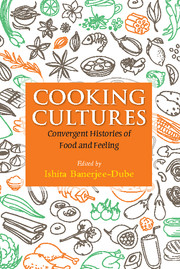Book contents
- Frontmatter
- Contents
- Acknowledgements
- Introduction: Culinary Cultures and Convergent Histories
- Part I Food, Pride, Power
- Part II Cooking, Cuisine, Gender
- 4 ‘Mem’ and ‘Cookie’: The Colonial Kitchen in Malaysia and Singapore
- 5 Modern Menus: Food, Family, Health and Gender in Colonial Bengal
- 6 Sweetness, Gender, and Identity in Japanese Culinary Culture
- Part III Food, Identity, Personhood
- Part IV Food, Myth, Nostalgia
- Contributors
- Index
- References
4 - ‘Mem’ and ‘Cookie’: The Colonial Kitchen in Malaysia and Singapore
from Part II - Cooking, Cuisine, Gender
Published online by Cambridge University Press: 05 July 2016
- Frontmatter
- Contents
- Acknowledgements
- Introduction: Culinary Cultures and Convergent Histories
- Part I Food, Pride, Power
- Part II Cooking, Cuisine, Gender
- 4 ‘Mem’ and ‘Cookie’: The Colonial Kitchen in Malaysia and Singapore
- 5 Modern Menus: Food, Family, Health and Gender in Colonial Bengal
- 6 Sweetness, Gender, and Identity in Japanese Culinary Culture
- Part III Food, Identity, Personhood
- Part IV Food, Myth, Nostalgia
- Contributors
- Index
- References
Summary
This article examines the history of colonial food practices in Malaysia and Singapore and of the contribution that Asian domestic servants made towards the development of this cuisine between the late-nineteenth century and the mid-twentieth century. In particular, it looks at the relationship between the British colonial mistress – ‘mem’ and the servant cook – ‘cookie’ and how this interaction contributed towards the emergence of colonial cuisine. Drawing upon a broad range of sources such as colonial cookbooks, diaries, travelogues and scholarly writings of historians who work on colonial foodways, this chapter explores the processes that made possible the emergence of unique dishes peculiar to colonial cuisine that had origins in British India: curry, mulligatawny, kedgeree, chicken chop, pishpash and the inimitable meal of tiffin, and their elaboration in Malaysia and Singapore.
The active participation of domestic servants – the agents of food practices – was vital for colonial cuisine. Cooks wielded far more influence on the diet of the British in Malaysia and Singapore than what has been acknowledged. The cook and his support staff were instrumental in the development of colonial cuisine. The cook and his assistants were much more than passive and subordinate domestic help who merely took and followed orders from the memsahib, the white mistress. The emergence of the cuisine peculiar to the itinerant colonising population was due to the evolvement of the distinctly social, cultural and political grouping that made up the European community. While there is a plethora of work on the history of regional Asian foodways (Cheung and Tan, 2007) and periods, specific research on colonial cuisines forms only a small subset. Cheung and Tan (2007) provide an excellent anthropological inquiry into ethnographic analysis of food production in several countries in Asia.
Among the handful of scholars to have considered food history and imperialism, some assume that consumption of certain types of foods became markers in distinguishing the colonials from the colonised. This school of thought contends that British colonisers consumed only British types of food in order to differentiate themselves from the colonised (Collingham, 2001, 159; Chaudhuri, 1992, 232). Nupur Chaudhuri examines the role played by British women in shaping the imperial world view of Victorians (Chaudhuri, 1992, 232).
- Type
- Chapter
- Information
- Cooking CulturesConvergent Histories of Food and Feeling, pp. 79 - 99Publisher: Cambridge University PressPrint publication year: 2016
References
- 2
- Cited by



